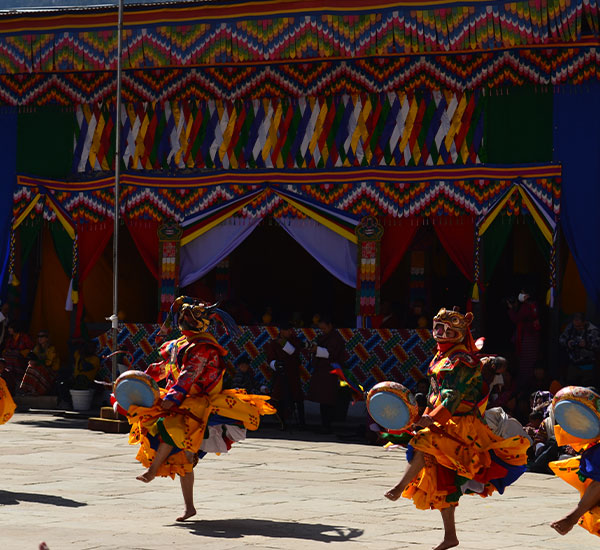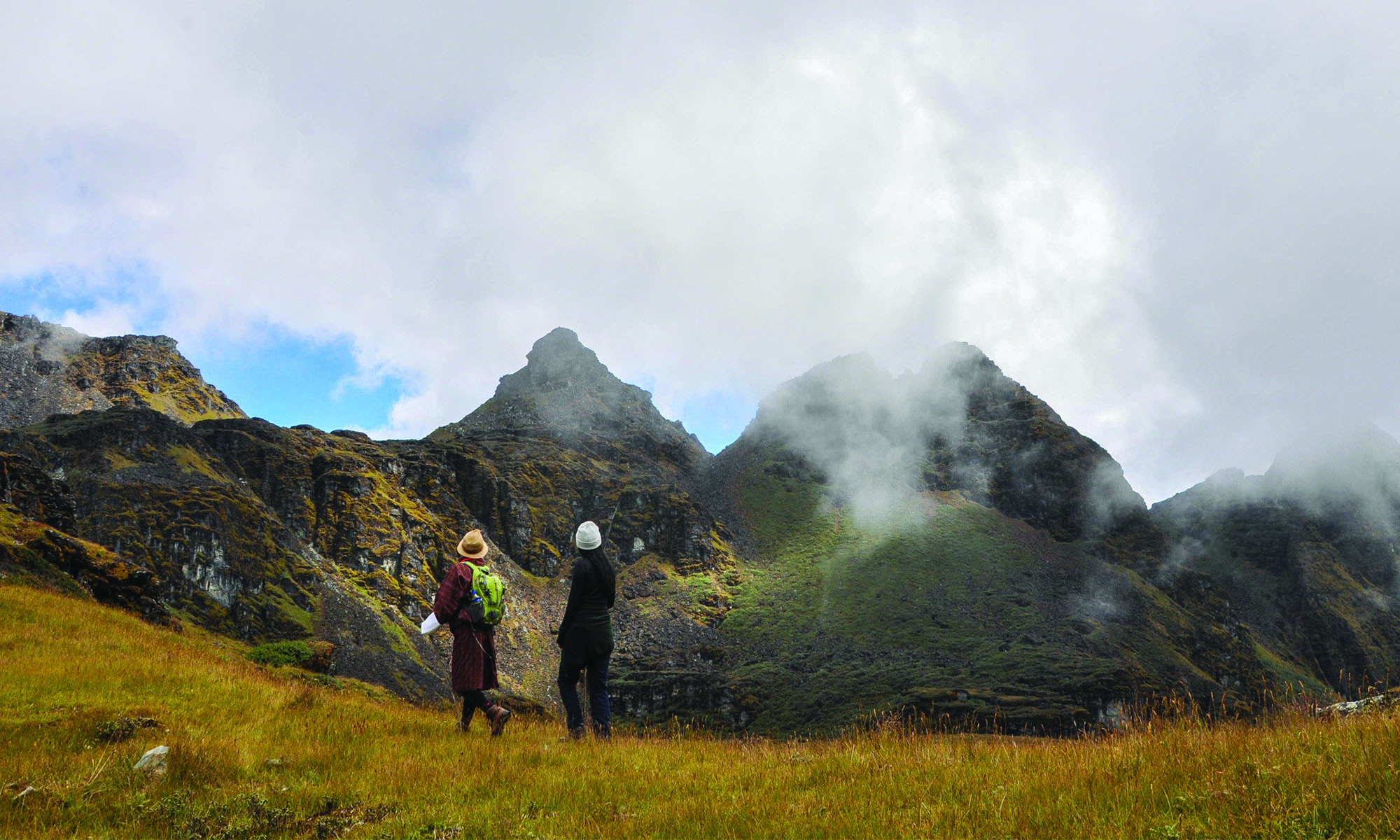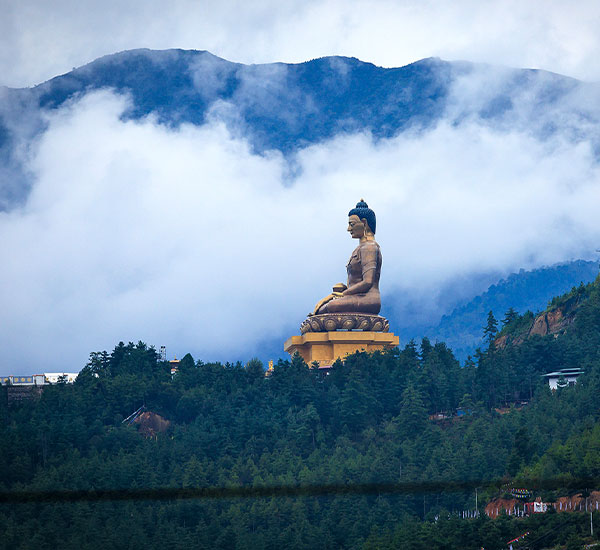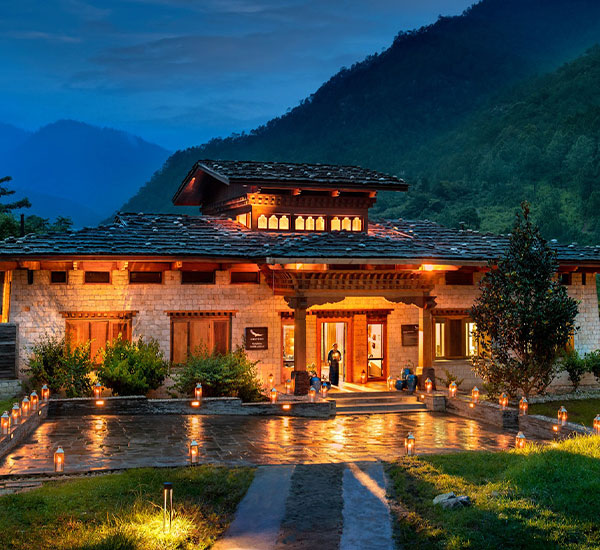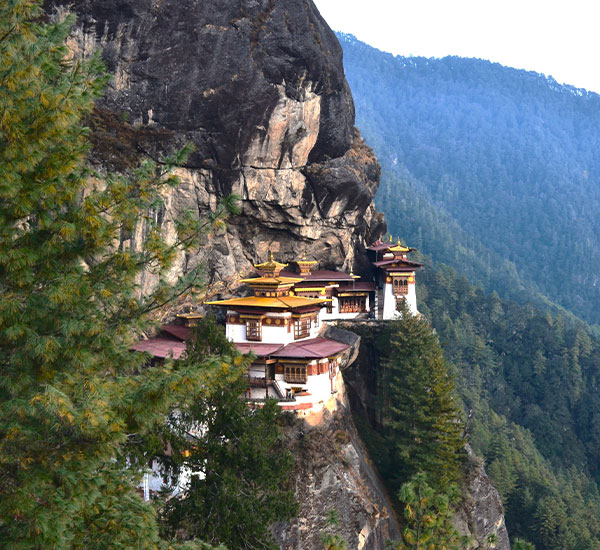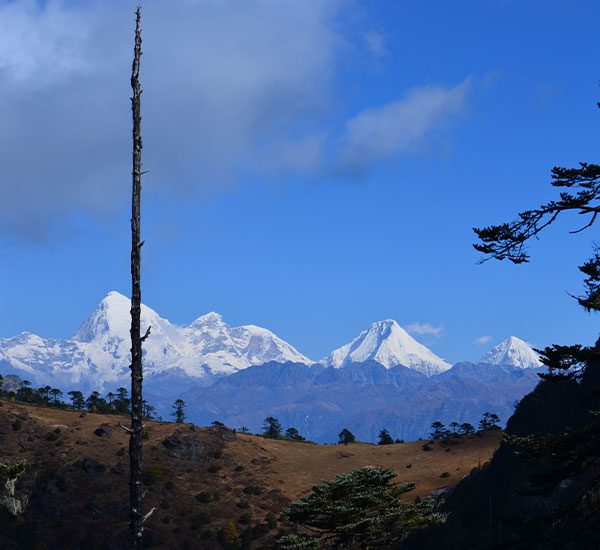Thimphu
The capital town of Bhutan, and the center of government, religion and commerce, Thimphu is a lively place, an interesting combination of tradition and modernity. Home to civil servants, expatriates and the monk body, Thimphu 22maintains a strong national character in its architectural style.
National Memorial Chorten
The building of this chorten was originally the idea of Bhutan’s third king, H.M. Jigme Dorji Wangchuck (“the father of modern Bhutan”), who had wished to erect a monument to world peace and prosperity, but was unable to give shape to his idea in his lifetime due to pressures of state. After His Majesty’s untimely death in 1972, the Royal Family and Cabinet resolved to fulfill his wishes and erect a memorial that would perpetuate his memory and also serve as a monument to peace. The National Memorial Chorten was consecrated on July 28, 1974. The finely executed wall paintings and delicately fashioned statues within the monument provide a deep insight into Buddhist philosophy.
Tashichhodzong
The “fortress of the glorious religion” was initially erected in 1641 and rebuilt by King Jigme Dorji Wangchuck in the 1960s. Tashichhodzong houses some ministries, His Majesty’s secretariat, and the central monk body. It is open to visitors during the Thimphu Tsechu (held in autumn) and while the monk body is resident in its winter quarters in Punakha.
Simtokha Dzong
This dzong, built in 1627 by Shabdrung Ngawang Namgyal, stands on a low ridge 8 km. down the valley from Thimphu. The Institute for Language and Culture Studies is located here. The most noteworthy artistic 26feature of this dzong is the series of over 300 finely worked slate carvings behind the prayer wheels in the courtyard.
National Library
The National Library was established in the late 1960s primarily to conserve the literary treasures which form a significant part of Bhutan’s cultural heritage. It now houses an extensive collection of Buddhist literature mostly in block-printed format, with some works several hundred years old. This collection, known as the Choekey Collection, mainly comprises Buddhist literature written in Choekey, the religious script of Northern Buddhism, but also includes works written in Tibetan and in Dzongkha, Bhutan’s national language. There is also a small Foreign Books Collection, stock of which mainly comprises works written in English, with subject interest on Buddhist studies, Bhutan, the Himalayan region and neighboring countries.
Institute for Zorig Chusum
Commonly known as the Painting School, the Institute offers a six-year course on the 13 traditional arts and crafts of Bhutan. On a visit one can see students learning the various skills taught at the school.
National Institute of Traditional Medicine
In Bhutan, equal emphasis is given to both allopathic and traditional medicines. The rich herbal medicines made up from medicinal plants abundant in the kingdom are prepared and dispensed here. The Institute is also a training school for traditional medicine practitioners.
Folk Heritage and National Textile Museums
These museums, both of which opened in 2001, provide fascinating insights into Bhutanese material culture and way of life.
Handicrafts shops:
A wide assortment of colorful, hand woven textiles and other craft products is available for purchase at the government-run Handicrafts Emporium and many smaller crafts shops around the town.
Weekend Market
Most of the Thimphu’s population and many valley dwellers converge on the bustling weekend market, held down by the river. A wide range of foodstuffs and local arts and crafts are sold at the market, which runs from Friday afternoon to Sunday. A visit to the market provides great photo opportunities, as well as the chance to mingle with local people and perhaps buy souvenirs.
Paro
This beautiful valley encapsulates a rich culture, scenic beauty and hundreds of myths and legends. It is home to many of Bhutan’s oldest temples and monasteries, the country’s only airport, and the National Museum. Mt. Chomolhari (7,300m) reigns in white glory at the northern end of the valley, its glacial waters plunging through deep gorges to form the Pa Chu (Paro river). The Paro valley is one of the kingdom’s most fertile, producing the bulk of Bhutan’s famous red rice from its terraced fields.
Taktshang
Taktshang monastery was built amazingly on a cliff. It brings pride to the Bhutanese about the work of their ancestors. Taktshang or the Tigers lair as the monastery is widely regarded is one of the most important in Bhutan. Its history is associated with the visit of Guru Padmasambhava, the Indian saint who came to Bhutan in the 8th century AD. The cave was named Taktshang after Guru Rinpoche flew into the cave from Kurtoe Singye Dzong in takeastern Bhutan riding on a tigress. When landing within the cave he took the wrathful form of Guru Dorji Drolo (one of the eight manifestations of Guru Rinpoche) to subdue the demons. It was not only a sacred site visited by Guru Rinpoche but was also visited and blessed by many others. From the road point the hike to Taktshang, on a well path, is quite uphill and it takes around 3-4 hours at an average walking speed. On a sunny day do remember to carry suns cream, water, walking stick and a hat.
Drukgyel Dzong
This dzong, with a picturesque village nestling below its ramparts, was built in 1646 by Shabdrung Ngawang Namgyal to commemorate his victory over the Tibetan invaders. Though largely destroyed by fire in 1951, the towering outer walls and central keep remain an imposing sight. On a clear day, there is a splendid view of Mt. Chomolhari from the approach road to Drukgyel Dzong.
Rinpung Dzong
The “fortress of the heap of jewels“ was built in 1646 by Shabdrung Ngawang Namgyal on a hill above the township. The approach to the Dzong is through a traditional covered bridge (called the Nemi Zam) and then up a paved stone path running alongside the imposing outer walls. The valley’s annual springtime religious festival, the Paro Tsechu, takes place in the courtyard of the dzong and on the dance ground on the hillside above.
Ta Dzong
On a ridge immediately above Rinpung Dzong is Ta Dzong, built as a watchtower to protect Rinpung Dzong. (“Ta” means “to see” in Dzongkha, so the watchtower of a dzong is always called a “Ta dzong”). On account of their function, watchtowers are always round in shape. In 1968 Paro’s Ta Dzong was inaugurated as the National Museum, and now holds a fascinating collection of art, relics, religious thangkha paintings, Bhutan’s exquisite postage stamps, coins and handicrafts, together with a small natural history collection.
Kyichu Lhakhang
This lhakhang, built in the 7th century, is one of the two oldest and most sacred shrines in 21Bhutan (the other being Jambey Lhakhang in Bumthang). Kyichu Lhakhang is composed of twin temples. The first temple was built by the Tibetan king, Songtsen Gampo in the 7th century. In 1968, H.M. Ashi Kesang, the Queen Mother of Bhutan, arranged for a second temple to be built alongside the first one, in same style.
Farm Houses
The natural beauty of Paro valley is enhanced by picturesque farm houses dotted about the fields and on the hillsides. The two to three-storied Bhutanese farm houses are handsome in appearance, with colorfully decorated outer walls and lintels, and are traditionally built without the use of single nail. All houses follow the same architectural style. A visit to a farm house gives an interesting glimpse into the lifestyle of a farming family.
Kila Gompa
This is the serene home of Buddhist nuns who have dedicated their lives to spiritual fulfillment. In this gompa, nestled in a craggy patch of rock on the mountainside below Chele-la pass, they spend their days in religious studies, prayer and meditation. Kila Gompa is about an hour’s walk from Chele-la, down a path through pine forest.
Druk Choeding
This temple in Paro town was built in 1525 by Ngawang Chhogyel, one of the prince-abbots of Raling in Tibet, and an ancestor of the Shabdrung, Ngawang Namgyal.
Punakha
Punakha served as the capital of Bhutan until 1955 and still it is the winter seat of the Je Khenpo (Chief Abbot). Blessed with a temperate climate and fed by the Pho Chu (male) and Mo Chu (female) rivers, Punakha is the most fertile valley in the country. There are splendid views from Dochu-la pass (3,088m/10,130ft) on the Thimphu – Punakha road.
Punakha Dzong
Placed strategically at the junction of the Pho Chu and Mo Chu rivers, the dzong was built in 1637 by Shabdrung Ngawang Namgyal to serve as the religious and administrative center of the region. Damaged over the centuries by four catastrophic fires and an earthquake, the dzong has been fully restored in recent years by the present monarch. The dzong is open for visitors during the Punakha festival (early spring) and in the summer months, after the monk body has returned to Thimphu.
Chime Lhakhang
Chime Lhakhang is a small built Temple in 15th century lies on a hillock shaped, Chimi Lhakhang is today one of the most revered and visited temples in Bhutan. People from all corners of the country visit the Lhakhang to seek blessings from Drukpa Kuenley. Especially the couples who visit the Lhakhang are blessed by a replication of the iron bow and arrows of Drukpa Kuenley, his scriptures and the phallus, which is the symbolic representation of fertility. It is said that during his life, the saint often used his phallus as a tool to impart his teachings. As part of the blessing a monk on duty will also select a name for the unborn child randomly from the list of names maintained at the temple. If it is a female name, couples can expect a girl and if the name drawn is that of a male, then a boy. Chime Lhakhang now comprises the main temple housing the statue of Drukpa Kuenley and his sacred relics, the statues of Lam Ngawang Chhoegyal and Choekim, and other prominent Buddhist saints and masters.
WANGDUEPHODRANG
Located south of Punakha and the last town before central Bhutan, Wangduephodrang is like an extended village with a few well-provisioned shops. The higher reaches of the Wangduephodrang valley provide rich pastureland for cattle. This district is famous for its fine bamboo work, stone carvings, and slate which is mined up a valley a few km. from the town.
Wangduephodrang Dzong
Stretched along the hilltop above the confluence of the Punakha Chu and Tang Chu rivers, the imposing Wangduephodrang Dzong is the town’s most visible feature. The dzong is open for visitors during Wangduephodrang Tsechu, celebrated in autumn.
Gangtey Gompa / Phobjikha
In the mountains east of Wangduephodrang lies the beautiful Phobjikha Valley, on the slopes of which is situated the great monastery of Gangtey, established in the 17th century. The village of Phobjikha lies a few km. down from the monastery, on the valley floor. This quiet, remote valley is the winter home of black necked cranes, which migrate from the arid plains of Tibet in the north, to pass the winter months in a milder climate.
TRONGSA
This town, perched on steep slopes above a river gorge, forms the central hub of the nation and is the place from where attempts at unifying the country were launched in former times. The landscape around Tongsa is spectacular and its impressive dzong, stretched along a ridge above a ravine, first comes into view about an hour before the winding, mountain road leads you into the town itself.
Chendebji Chorten
En route to Tongsa is Chendebji Chorten, patterned on Kathmandu’s Swayambhunath Stupa, with eyes painted at the four cardinal points. It was built in the 18th century by Lama Shida from Tibet, to cover the remains of an evil spirit that was subdued at this spot.
Tongsa Dzong
Built in 1648, it was the seat of power over central and eastern Bhutan. Both the first and second kings of Bhutan ruled the country from this ancient seat. All four kings were invested as Tongsa Penlop (“governor”) prior to ascending the throne, and the present Crown Prince now holds the post. The dzong is a massive structure with many levels, sloping down the contours of the ridge on which it is built. Because of the dzong’s highly strategic position, on the only connecting route between east and west, the Tongsa Penlop was able to control effectively the whole of the central and eastern regions of the country from here.
Ta Dzong
This watchtower, which once guarded Tongsa Dzong from internal rebellion, stands on a steep slope above the town. Climb up the path to visit Ta Dzong which now houses a shrine dedicated to the epic hero, King Gesar of Ling. A visit to this former watchtower provides visitors with an insight into the significance of Tongsa in Bhutan’s history.
BUMTHANG
This lovely valley is the religious heartland of the nation and home to some of its oldest Buddhist temples and monasteries. Tales of Guru Padmasambhava and the tertons (“religious treasure-discoverers”) still linger in this sacred region.
Jambey Lhakhang
This monastery was built in the 7th century by the Tibetan king, Songtsen Gampo. It is one of 108 monasteries which he built to subdue evil spirits in the Himalayan region. Its present architectural appearance dates from the early 20th century./p>
Kurje Lhakhang
Located further along the valley, Kurje Lhakhang comprises three temples. The one on the right was built in 1652 against the rock face where Guru Padmasambhava meditated in the 8th century. The middle temple is built on the site of a cave containing a rock with the imprint of the Guru’s body, and is therefore considered to be the most holy. The temple on the left was built in the 1990s by H.M. Ashi Kesang, the Queen Mother. These 88three temples are surrounded by a 108 chorten wall.
Tamshing Lhakhang
Located across the river from Kurje Lhakhang, this temple was founded in 1501 by Terton Pema Lingpa, a re-incarnation of Guru Padmasambhava. There are very old religious paintings around the inner walls of the temple, which was restored at the end of the 19th century.
Jakar Dzong
Constructed in 1549 by the great grandfather of the first Shabdrung, the dzong was initially built as a monastery. It was upgraded in 1646, after the Shabdrung had firmly established his power. Jakar Dzong is now used as the administrative center for Bumthang valley, and also houses the regional monk body.
MONGAR
The journey from Bumthang to Mongar, crossing over the 4,000m high Thrumsing-la pass, is scenically spectacular. Mongar marks the beginning of eastern Bhutan. The second largest town in the subtropical east, Mongar is built high on a gently sloping hillside.
Mongar Dzong
Although built in the 1930s and one of Bhutan’s newest dzongs, it is constructed in the same way as all earlier dzongs, without plans or nails. A visit to Mongar Dzong shows one how traditional Bhutanese architecture has continued to thrive through the centuries.
TRASHIYANGTSE
Tashiyangtse is a rapidly growing town and administrative center for this district. Situated in a small river valley, it is a lovely spot from which to take walks in the surrounding countryside. The dzong overlooking the town was built in the late 1990s when the new district was created. Tashiyangtse is famous for its wooden containers and bowls, which make inexpensive, attractive and useful mementos of a visit to this remote region. The Institute for Zorig Chusum, where students study the 13 traditional arts and crafts of Bhutan, is also worth a visit.
Chorten Kora
This dazzling white stupa is situated on the riverbank below the town. Constructed in 1740 by Lama Ngawang Loday, it is built in the same style as Bodnath Stupa in Nepal, with eyes painted at the four cardinal points. During the second month of the lunar calendar there is an interesting celebration here, known as ‘Kora’.
Bomdeling
A pleasant walk of about three hours from Chorten Kora, Bomdeling is an annual migration place for black necked cranes, which fly over from nearby Tibet to pass the winter months in a warmer climate.
TRASHIGANG
Tashigang lies in the far east of Bhutan, and is the country’s largest district. Tashigang town, on the hillside above the Gamri Chu (river), was once the center for a busy trade with Tibet. Today it is the junction of the east-west highway, with road connections to Samdrup Jongkhar and then into the Indian state of Assam. This town is also the principle market place for the semi-nomadic people of Merak and Sakteng, whose way of dress is unique in Bhutan.
Tashigang Dzong
Built in 1659, the dzong serves as the administrative seat for the district as well as the home of the monk body. The dzong commands a remarkable view over the surrounding countryside.
Gom Kora
24 km. from Tashigang, the temple of Gom Kora is set on a small alluvial plateau overlooking the river. Surrounded by rice fields and clumps of banana trees, it looks like an oasis in an arid landscape. It is one of the famous places where Guru Rinpoche meditated in order to subdue a demon which dwelt in a huge black rock.
SAMDRUP JONGKHAR
The road from Tashigang to Samdrup Jongkhar, completed in the 1960s, enables the eastern half of the country to access and benefit from trade with the south as well as across the Indian border. There is little to see in this area, other than the busy market which straddles the border. Samdrup Jongkhar is a convenient exit town for tourists who have arranged to visit the neighboring Indian state of Assam.
PHUENTSHOLING
The gateway to the south, this town is a thriving commercial center on the northern edge of the Indian plains. Situated directly at the base of the Himalayan foothills, Phuentsholing is a fascinating mixture of Indian and Bhutanese, a perfect example of the mingling of peoples and cultures. Being a border town, Phuentsholing is a convenient entry/exit point for visiting Bhutan and also the neighboring Indian states of West Bengal, Sikkim and Assam.
Kharbandi Gompa
This beautiful monastery situated in a garden of tropical plants and flowers at an altitude of 400m /1,300ft above the town, was founded in 1967 by the Royal Grandmother, Ashi Phuntsho Choedron. The monastery contains paintings depicting scenes from the life of the Buddha and statues of Shabdrung Ngawang Namgyal and Guru Rinpoche. From the monastery garden there is a splendid view of Phuentsholing and the plains of West Bengal with their tea gardens beyond.
Zangtho Pelri
This small temple built in the center of Phuentsholing town represents the heaven of Guru Rinpoche. At ground level there are statues of the eight manifestations of Guru Rinpoche and paintings depicting scenes from the life of the Buddha. The floor above contains wall paintings of the eight Bodhisattvas and statues of Avalokiteshvara and Shabdrung Ngawang Namgyal. On the top floor, the main statue is of Amitabha.
